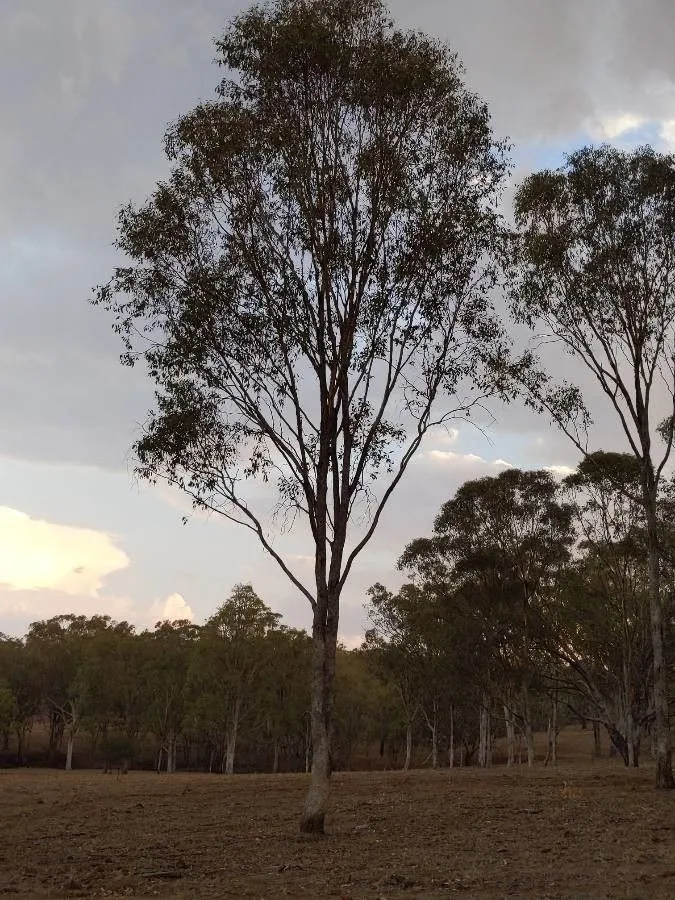
Author: (Maiden) Maiden
Bibliography: Crit. Revis. Eucalyptus 6: 438 (1923)
Year: 1923
Status: accepted
Rank: species
Genus: Eucalyptus
Vegetable: False
Observations: S. Queensland to SE. Australia
Eucalyptus microcarpa, commonly known as the Inland Grey-box, is a resilient and significant species of tree that belongs to the family Myrtaceae. Originating from the work of botanist Joseph Maiden, its formal botanical description appeared in Crit. Revis. Eucalyptus in 1923.
Predominantly found in the regions spanning from southern Queensland to southeastern Australia, the Inland Grey-box thrives in these diverse and varying climatic zones. This tree is particularly noted for its adaptability to the dry inland environments, where it typically forms part of the woodland ecosystems.
The Eucalyptus microcarpa stands out due to its distinctive greyish bark, which peels in irregular patches, revealing a smooth, pale surface beneath. The foliage of the Inland Grey-box is another key feature, with lance-shaped leaves that are a dusky green on top and paler underneath. The small, bell-shaped flowers are usually creamy-white and appear in clusters, contributing to the biodiversity of the regions they inhabit by providing a food source for various pollinators, including bees.
Beyond its ecological role, the Inland Grey-box is valued for its hardwood. The timber, durable and dense, is often used in construction, fencing, and for making tools. Additionally, Indigenous Australians have long recognized the utility of this tree, using its bark and wood for various traditional purposes.
The Inland Grey-box’s ability to withstand harsh conditions also makes it crucial for soil stabilization and in providing habitat for wildlife in the arid and semi-arid landscapes of Australia. Conservation efforts continue to ensure that this species, which reflects the resilience of Australia’s native flora, remains a vital part of its natural heritage.
In summary, Eucalyptus microcarpa is a remarkable testament to the endurance and diversity of Australian native plants, playing an essential role both ecologically and economically.
Por: eucalipto
Eng: grey-box, gum-top-box, inland grey-box, inland-box, inland-grey-box, narrow-leaf-box, narrow-leaved-box, western grey-box, grey box, inland box
En: Inland grey-box, Grey-box, Western grey-box, Gum-top-box, Narrow-leaf-box, Inland-box, Inland-grey-box, Narrow-leaved-box, Grey Box, Inland Box
Fa: اکالیپتوس ریزمیوه
Pt: Eucalipto
Taken Jul 25, 2022 by Michal Svit (cc-by-sa)
Taken Nov 18, 2020 by J Y Liew (cc-by-sa)
Taken Nov 18, 2020 by J Y Liew (cc-by-sa)
Taken Jul 19, 2021 by Gervais Théo (cc-by-sa)
Taken Jan 1, 2020 by Cook David (cc-by-sa)
Taken Jan 1, 2020 by Cook David (cc-by-sa)
Taken Oct 10, 2019 by R Tearche (cc-by-sa)
Taken Jan 1, 2020 by Cook David (cc-by-sa)
Taken May 28, 2021 by Tama Brightwell (cc-by-sa)
Taken May 28, 2021 by Tama Brightwell (cc-by-sa)
Taken Aug 14, 2020 by Ross Jones (cc-by-sa)
Taken Oct 10, 2019 by R Tearche (cc-by-sa)
Taken Jan 1, 2020 by Cook David (cc-by-sa)
© copyright of the Board of Trustees of the Royal Botanic Gardens, Kew.
Family: Myrtaceae Author: (F.Muell.) K.D.Hill & L.A.S.Johnson Bibliography: Telopea 6: 402 (1995) Year: 1995 Status:…
Family: Rubiaceae Author: Pierre ex A.Froehner Bibliography: Notizbl. Bot. Gart. Berlin-Dahlem 1: 237 (1897) Year:…
Family: Sapindaceae Author: Koidz. Bibliography: J. Coll. Sci. Imp. Univ. Tokyo 32(1): 38 (1911) Year:…
Family: Asteraceae Author: A.Gray Bibliography: Pacif. Railr. Rep.: 107 (1857) Year: 1857 Status: accepted Rank:…
Family: Fabaceae Author: Medik. Bibliography: Vorles. Churpfälz. Phys.-Ökon. Ges. 2: 398 (1787) Year: 1787 Status:…
Family: Aspleniaceae Author: (Cav.) Alston Bibliography: Bull. Misc. Inform. Kew 1932: 309 (1932) Year: 1932…